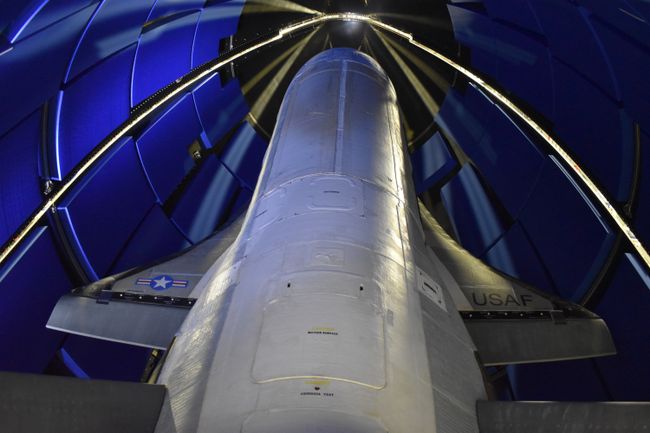Welcome to DU!
The truly grassroots left-of-center political community where regular people, not algorithms, drive the discussions and set the standards.
Join the community:
Create a free account
Support DU (and get rid of ads!):
Become a Star Member
Latest Breaking News
General Discussion
The DU Lounge
All Forums
Issue Forums
Culture Forums
Alliance Forums
Region Forums
Support Forums
Help & Search
Science
Related: About this forumWhy a microwave-beam experiment will launch aboard the Air Force's secretive X-37B space plane
By Rafi Letzter - Staff Writer 4 hours ago
The scientific experiment offers a first look at the secretive space plane's orbital activities.

A Boeing image shows the X-37B in its capsule before launch.
(Image: © Boeing/US Space Force)
A secretive military space plane will soon test the idea of using microwave beams to send solar power to Earth from space. The U.S. Air Force's X-37B space plane is expected to launch into orbit Saturday (May 16) with an experiment onboard that tests the possibility.
The Photovoltaic Radiofrequency Antenna Module Flight Experiment (PRAM-FX) represents the first orbital test of such a sci-fi technology since the 19th century — solar satellite power. Build a big solar array in orbit, the idea goes, and it could collect enough sunlight (unfiltered by atmospheric effects or clouds,) to generate a powerful beam of microwaves. A collection station on Earth would then convert that beam into useful power. Launch any satellite into a high enough orbit and it will receive a near-constant stream of sunlight, with only brief passes through the Earth's shadow. A whole constellation of solar arrays might offer uninterrupted 24/7 power.
"The idea got a lot of attention, and sort of came into its own in the late 60s, early 70s, when there became an imperative to explore energy sources other than fossil fuels ," when fossil fuel supplies became unstable and prices skyrocketed, said Paul Jaffe, a civilian electronics engineer at the U.S. Naval Research Laboratory (NRL) and leader of the NRL's beamed energy research.
That research tapered off as fuel prices dropped, Jaffe said. But in 2007, the Department of Defense picked up the baton. A satellite beam is a much safer and more efficient way of getting power to an overseas military base than convoys of fuel trucks, he said. Those trucks, stuffed with combustible fuel, can be attacked and destroyed, risking the lives of their drivers and guards. But a microwave beam passes invisibly through the atmosphere unguarded. You can't shoot at it.
More:
https://www.livescience.com/microwave-beam-military-space-plane.html?utm_source=notification
InfoView thread info, including edit history
TrashPut this thread in your Trash Can (My DU » Trash Can)
BookmarkAdd this thread to your Bookmarks (My DU » Bookmarks)
3 replies, 920 views
ShareGet links to this post and/or share on social media
AlertAlert this post for a rule violation
PowersThere are no powers you can use on this post
EditCannot edit other people's posts
ReplyReply to this post
EditCannot edit other people's posts
Rec (2)
ReplyReply to this post
3 replies
 = new reply since forum marked as read
Highlight:
NoneDon't highlight anything
5 newestHighlight 5 most recent replies
= new reply since forum marked as read
Highlight:
NoneDon't highlight anything
5 newestHighlight 5 most recent replies
Why a microwave-beam experiment will launch aboard the Air Force's secretive X-37B space plane (Original Post)
Judi Lynn
May 2020
OP
So about those solar power satellites in the 1800s. How did they get up there?
GriffenRamsey
May 2020
#2
LunaSea
(2,893 posts)1. This is a long overdue experiment
I look forward to the results.
GriffenRamsey
(181 posts)3. see below...
GriffenRamsey
(181 posts)2. So about those solar power satellites in the 1800s. How did they get up there?
"The Photovoltaic Radiofrequency Antenna Module Flight Experiment (PRAM-FX) represents the first orbital test of such a sci-fi technology since the 19th century — solar satellite power."
 ?content-type=image%2Fjpeg
?content-type=image%2Fjpeg